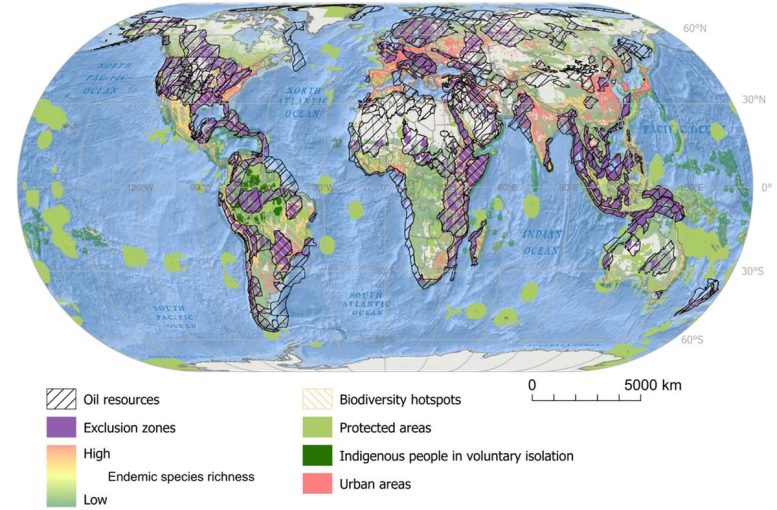
The study presents the atlas of unburnable oil in the world, designed based on environmental and social criteria to reduce CO₂ emissions in the atmosphere, combat the effects of climate change and comply with this international treaty, signed in 2015 in Paris as part of the UN Climate Change Conference (COP21). Credit: Nature Communications
A study led by the University of Barcelona warns of the oil resources that should not be exploited to meet the commitments of the Paris Agreement on climate change.
In order to limit the increase in global average temperature to 1.5°C, it is essential to drastically reduce carbon dioxide (CO₂) emissions in the atmosphere. This would mean not exploiting most of the existing coal, conventional gas, and oil energy resources in regions around the world, according to research led by the University of Barcelona and published in the journal Nature Communications. The new article presents the atlas of unburnable oil in the world, a world map designed with environmental and social criteria that warns which oil resources should not be exploited to meet the commitments of the Paris Agreement signed in 2015 to mitigate the effects of climate change.
The article is led by Professor Martí Orta-Martínez, from the UB’s Faculty of Biology and the UB Biodiversity Research Institute (IRBio), and co-authored by Gorka Muñoa and Guillem Rius-Taberner (UB-IRBio), Lorenzo Pellegrini and Murat Arsel, from the Erasmus University Rotterdam (The Netherlands), and Carlos Mena, from the University of San Francisco de Quito (Ecuador).
The unburnable oil atlas reveals that to limit global warming to 1.5°C, it is essential to avoid the exploitation of oil resources in the most socio-environmentally sensitive areas of the planet, such as natural protected areas, priority areas for biodiversity conservation, areas of high endemic species richness, urban areas and the territories of indigenous peoples in voluntary isolation. It also warns that not extracting oil resources in these most sensitive areas would not be enough to keep global warming below 1.5°C as indicated in the Paris Agreement.
Oil Exclusion Zones Around the Globe
The Paris Agreement is an international treaty on climate change that calls for limiting global warming to below 2°C above pre-industrial levels and making efforts to limit it to 1.5°C. It was signed by 196 countries on 12 December 2015 at the UN Climate Change Conference COP21 in Paris and has been in force since 4 November 2016.
In this context, the unburnable oil atlas provides a new roadmap to complement the demands of international climate policy — based primarily on demand for fossil fuels — and to enhance socio-environmental safeguards in the exploitation of energy resources.
“Our study reveals which oil resources should be kept underground and not commercially exploited, with special attention to those deposits that overlap with areas of high endemic richness or coincide with outstanding socio-environmental values in different regions of the planet. The results show that the exploitation of the selected resources and reserves is totally incompatible with the achievement of the Paris Agreement commitments,” says Professor Martí Orta-Martínez.
There is now a broad consensus among the scientific community to limit global warming to 1.5°C if we want to avoid reaching the tipping points of the Earth’s climate system, such as melting permafrost, loss of Arctic sea ice and the Antarctic and Greenland ice sheets, forest fires in boreal forests, and so on. “If these thresholds are exceeded, this could lead to an abrupt release of carbon into the atmosphere (climate feedback),” Orta-Martínez states, and adds that this would “amplify the effects of climate change and trigger a cascade of effects that commit the world to large-scale, irreversible changes.”
What Would Happen if All Known Fossil Fuels Were Burned?
To limit average global warming to 1.5°C, the total amount of CO₂ emissions that must not be exceeded is known as the remaining carbon budget. In January 2023, the remaining carbon budget for the 50 % chance of keeping warming to 1.5°C was about 250 gigatonnes of CO₂ (GtCO2). “This budget is steadily decreasing at current rates of human-induced emissions — about 42 GtCO2 per year — and will be completely used up by 2028,” says researcher Lorenzo Pellegrini.
The combustion of the world’s known fossil fuel resources would result in the emission of about 10,000 GtCO2, forty times more than the carbon budget of 1.5°C. “In addition, the combustion of developed fossil fuel reserves — i.e. those reserves of oil and gas fields and coal mines currently in production or under construction — will emit 936 GtCO2, four times more than the remaining carbon budget for a global warming of 1.5°C,” notes expert Gorka Muñoa.
“The goal of no more than 1.5°C global warming requires a complete halt to exploration for new fossil fuel deposits, a halt to the licensing of new fossil fuel extraction, and the premature closure of a very significant share (75%) of oil, gas and coal extraction projects currently in production or already developed,” the authors note.
With the prospect of the results of the study, which has received funding from the Spanish Ministry of Science and Innovation and the European Union’s Next Generation funds, the authors call for urgent action by governments, corporations, citizens and large investors — such as pension funds — to immediately halt any investment in the fossil fuel industry and infrastructure if socio-environmental criteria are not applied. “Massive investment in clean energy sources is needed to secure global energy demand, enact and support suspensions and bans on fossil fuel exploration and extraction, and adhere to the fossil fuel non-proliferation treaty,” the team concludes.
Reference: “The atlas of unburnable oil for supply-side climate policies” by Lorenzo Pellegrini, Murat Arsel, Gorka Muñoa, Guillem Rius-Taberner, Carlos Mena and Martí Orta-Martínez, 14 March 2024, Nature Communications.
DOI: 10.1038/s41467-024-46340-6









Thanks, University of Barcelona. Spain emitted 261 million metric tons of CO2 in 2022, and 48 million of methane in 2021 (Statista). Barcelona declared a climate emergency in 2020. Instead of a new Spanish Empire telling people around the world what they cannot do, let’s just start with an atlas with only Spain purple first.
That 48 Mt of methane is actually CO2 equivalent tons, not actual methane Megatons. However, https://ourworldindata.org/grapher/methane-emissions?country=~ESP doesn’t say whether it is the often quoted 20-year equivalent or the Kyoto Protocol recommended 100-year equivalent. Therefore, the actual methane emission weight is either 1.6 Mt, or the preferred 4.8 Mt per year. One has to watch closely to follow which shell the pea is under when it comes to claims made by the media.
On further reflection, the World In Data doesn’t indicate whether they just multiplied the Global Warming Potentials (83 or 28) times the weight of methane emissions, or corrected for the difference in molecular weight between CH4 and CO2 to put them on a molecule-by-molecule basis such as ppmv, as I did because that is how it is usually measured. I suspect that the methane weights should either be 0.57 Mt or 1.7 Mt.
Thanks, it was a carbon dioxide equivalent. I didn’t see that “MtCO₂e”. I had tried OurWorldInData, and it was broken, telling me other countries are Spain. Funny how they don’t divide CO2 by methane equivalent.
It’s the imperial authoritarian push that bothers me in these types of articles. It’s the Spanish telling everyone from the Somalians to the Americans what they’re allowed to do. Spain is mostly temperate, where people don’t need as much energy to survive, yet they still use a great deal, and want to dictate to Siberians and Alaskans. Not to mention, for some reason, the gas and oilfields of Spain are all suspiciously missing from the map.
It seems that the word “ethics” is a ‘foreign’ word regardless of what the native language is. I’m sometimes tempted to believe that the world is devolving into a world where truth is no longer respected. However, Mark Twain quipped that “If you don’t read the news, you are uninformed. If you do read the news, you are misinformed.” I guess things haven’t really changed much.
Regardless of who the authors are, it’s obvious that even not using oil or coal from the most “sensitive” areas is insufficient to reach the 1.5C limit. Fossil fuel use is declining, but not fast enough. Spain is one of the leaders in using solar power in Europe, not surprising given its sunny climate.
Governments need to stop subsidizing fossil fuels and find alternatives such as solar, wind, geothermal, nuclear, hydro, wood waste & burning household waste. Aviation and shipping fuel needs to be taxed. Some countries also do not tax fossil fuels sufficiently to encourage a pivot.